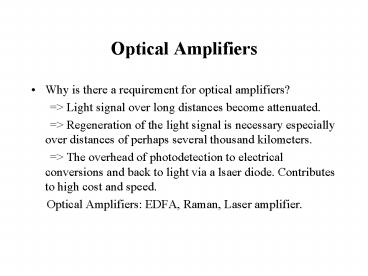Optical Amplifiers - PowerPoint PPT Presentation
1 / 11
Title:
Optical Amplifiers
Description:
The erbium ions decay rapidly to . They experience an atomically long lifetime ... Spontaneous decay of erbium ions from E2 to E1 will generate noise in the ... – PowerPoint PPT presentation
Number of Views:176
Avg rating:3.0/5.0
Title: Optical Amplifiers
1
Optical Amplifiers
- Why is there a requirement for optical
amplifiers? - gt Light signal over long distances become
attenuated. - gt Regeneration of the light signal is
necessary especially over distances of perhaps
several thousand kilometers. - gt The overhead of photodetection to
electrical conversions and back to light via a
lsaer diode. Contributes to high cost and speed. - Optical Amplifiers EDFA, Raman, Laser
amplifier.
2
Erbium Doped Fibre Amplifier
- Fibre amplifier
- Core region is doped with ions.
- Another rare earth ion dopant that is used is the
neodynium ion ( ) - Host fibre is glass based.( ) with
other glass forming oxides ( ) - Important factor It is possible to have
relatively high concentrations of erbium in the
core (up to 1000 ppm).
3
Erbium Doped Fibre Amplifier
- Refer to energy diagram.
- Erbium ions are optically pumped, typically by a
980 nm laser diode. is raised to . - The erbium ions decay rapidly to . They
experience an atomically long lifetime here (10
ms). - Decays from
- Therefore there is an accumulation of erbium ions
at sitting 0.80 eV above ground. - This accumulation of erbium ions lead to a
population inversion between . - Photons at 1550 nm have an energy of 0.80eV (
).
4
EDFA
- This triggers stimulated emission of erbium ions
from - Erbium ions left at E1 will absorb the incoming
1550 nm photons and rise to E2. - Stimulated emission must exceed light absorption
to achieve light amplification. - Therefore there must be more erbium ions at E2
then at E1.
5
EDFA
- Assume N2 and N1 are the number if erbium ions at
E2 and E1. - The difference between stimulated emission (E2
toE1) and absorption (E1 to E2) rate controls the
optical gain. - where K is a constant that depends on
pumping intensity.
6
EDFA
- Considerations
- Spontaneous decay of erbium ions from E2 to E1
will generate noise in the amplified light
signal. - If the EDFA is not pumped then it presents itself
as an attenuator. 1550 nm photons will be
absorbed by ions which will rise from E1
to E2.
7
EDFA
- The range of stimulated transistions from E2 to
E1 correspond to a wavelength range of 1525 to
1565 nm that can be amplified. - This delivers an optical bandwidth of 40 nm.
- This permits usage with a WDM.
- Problem gt Gain is not uniform across bandwidth.
- Techniques must be implemented to flatten the
response.
8
(No Transcript)
9
(No Transcript)
10
EDFA
- Factors controlling the degree of gain
uniformity - Concentrations of the active ion (erbium).
- Optical gain flattening filter.
- Additional (second ) pump laser at each end of
the fibre. - One pump beam propagates with signal
beam while the other propagates against it.
Ensures that population inversion and gain
remains constant along the fiber.
11
EDFA
- Physical Components of EDFA
- Biconical fused fibre couplers.
- One or two (if high output required) laser pumps.
- Polarization-insensitive optical isolators front
and back. Allows only 1550 nm signals to pass.
Pump radiation should not enter main fibre as
well as optical feedback from reflections. - Optical filter for gain flattening.
- Phgotodetector system to monitor pump power or
EDFA output power.































